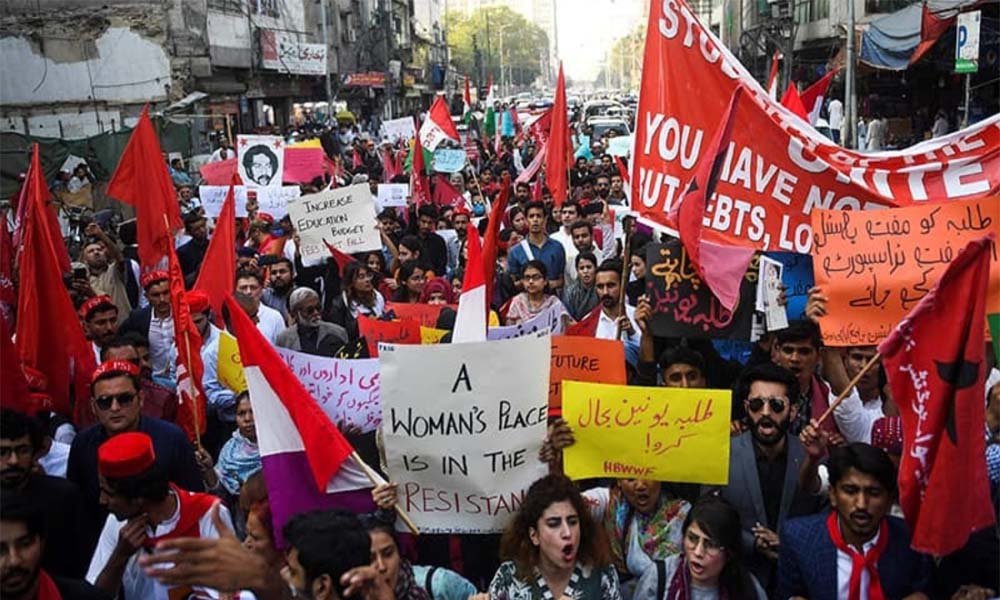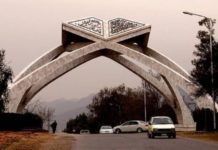Disclaimer: The Eqbal Ahmad Centre for Public Education (EACPE) encourages critical and independent thinking and believes in a free expression of one’s opinion. However, the views expressed in contributed articles are solely those of their respective authors and do not necessarily reflect the position or policy of the EACPE.
Ever since institutes of higher education came into existence, they have served as crucibles for forging of new thought, ideologies, and catalysts for social and political change. Youth is by its very nature imbued with physical and emotional energy and a bravado which eggs them on to take on formidable state might. Student activism over the world has succeeded in changing the course of history and left an inspiration for later generations of students. Commonly associated with left-wing ideology, right-wing student movements have been very common too. China, Hong Kong, United States, Germany, France, Argentina, Australia, Congo, Bangladesh and so on, there is hardly a country on the globe that has not been affected by student activism. Regardless of the degree of immediate success student protests might have achieved in achieving their goals, many of them triggered waves of activism or unrest whichever way one might look at it, and could in no way be ignored or blocked out by the establishments. They had to sit up and take notice and many times rethink and reframe policies.
Student activism has played a major role in the modern Chinese history. The student protest for democracy in Tiananmen Square, China, 1989, triggered a nationwide chain of protests for ending government repression. Though it ended in unleashing a brutal and tragic massacre by the government, it continues to serve as an inspiring example for student activists over the world.
The Velvet Revolution started in the same year in Prague, Czechoslovakia when the students took out an anti-communism rally against a totalitarian government. They were attacked by the riot police, gravely injuring 167 of them. But rather than suppress the student movement, it resulted in unifying people against the government tyranny and seventy five percent of the nation went on a partial strike the next day. The series of protests succeeded in bringing down the communist regime and introducing democratic elections in 1990.
Student activism in Congo in 1969 pushed the country towards decolonization of higher education and national independence, attaining a fair amount of success.
In 1942, students from the University of Munich formed a resistance group by the name of White Rose to resist the Nazi atrocities. The group leaders were eventually tried and executed, but managed to awaken many others to stand up against an evil regime.
Politically aware and socially conscious students cannot be expected to be mute spectators to perceived injustice and hegemony.
Sixty four percent of Pakistanis are under the age of thirty. There are over two million students enrolled in universities and colleges. All these students are well aware and alert to global and national changes. The social media keeps them constantly updated about every trending event, political and social issue helping them to form well informed personal opinions and perspective about government policies and legalities in perspective of the constitution and a larger world view. Given the passion and enthusiasm of youth, their beliefs and opinions tend to be fired with hyper emotionalism which is difficult to contain. It must be expressed, and expressed strongly. They find strength in numbers and solidarity and a naive belief in academic idealism.
In pre-partition India, the history of student activism through political and social consciousness takes us back to the Young Bengal movement in the Hindu College (now Presidency College), West Bengal in the year 1830. It was a movement for Liberty, equality and Fraternity and against religious bigotry. It was started by a poet named Derozio and was quickly picked up by various colleges in Bengal. Students from over the country joined Gandhi’s Non Co-operation Movement of 1920, and later the Quit India Movement.
In Pakistan, university students have spearheaded protest against military regimes. In 1960, the National Students Federation and Peoples Student Federation protested against General Ayub Khan’s regime. Malala Yousazai, shot by the Taliban in 2012 for resisting their ban on girls’ education, went on to become an iconic activist for women’s educational rights.
It is interesting to observe the similarities in the perspective and management of student protests by the Indian and Pakistani governments. The protest by Jawaharlal University students in 2016 against the execution of Afzal Guru, a Kashmiri separatist is only too recent and became the reason for a country wide debate. Most universities in Pakistan force students to sign an affidavit declaring not to participate in political activity. Recently in November, thousands of students organized protest marches termed as the Students Solidarity March in fifty cities of Pakistan, in favour of their right to restore student unions. Students in Pakistan sang Bollywood songs like “Itne baazu itne sar…” while student marchers in India evoke the spirit of redemption through Faiz’s iconic compilation, “Hum Dekhenge…” Both Indian and Pakistani establishments dub the protests as anti national and provoked by the bête noir!
Politically aware and socially conscious students cannot be expected to be mute spectators to perceived injustice and hegemony. An education system which does not qualify them to question and challenge the existing theories and policies is useless and must be questioned for its own validity. To justify one’s education, it is imperative for all educated persons to understand, analyse issues and take a rational perspective. Should they be penalised if their perspective is contrary to that of the government? We need to revisit the concept of a democratic republic here. Is it possible to restrain student anger and dissent through force? History tells us otherwise.
Today the Indian and Pakistani establishments are being questioned by a major portion of their youth again about the justice and fairness of their policies. More and more students are raising their voice despite the tear gas and lathi charges. Their voices are too loud and too strong to be muted. The governments must listen before its social fabric is ripped apart. It must realize that the students do not stand in isolation. Behind each student stand a supportive family, faculty and circle of friends and well wishers. Let not student activism be viewed as a challenge to institutional authority alone. For a healthy political system, it is essential to listen to and give credence to the voice of youth who will shape the future of this country. It should be remembered that storms can brew in a tea cup!
About the Author:
 Dr Ranjit Powar is a psychologist who has served with the Punjab Civil Services and earlier as a lecturer with the Punjabi University, Patiala. Besides writing as a freelancer, she works with NGOs for imparting employability training to high school students.
Dr Ranjit Powar is a psychologist who has served with the Punjab Civil Services and earlier as a lecturer with the Punjabi University, Patiala. Besides writing as a freelancer, she works with NGOs for imparting employability training to high school students.








